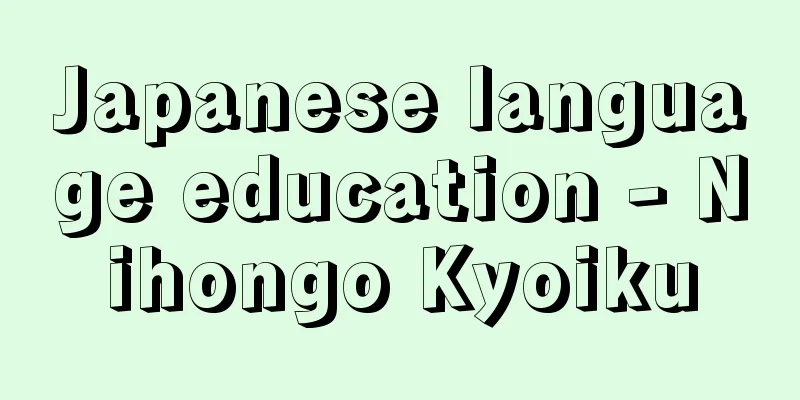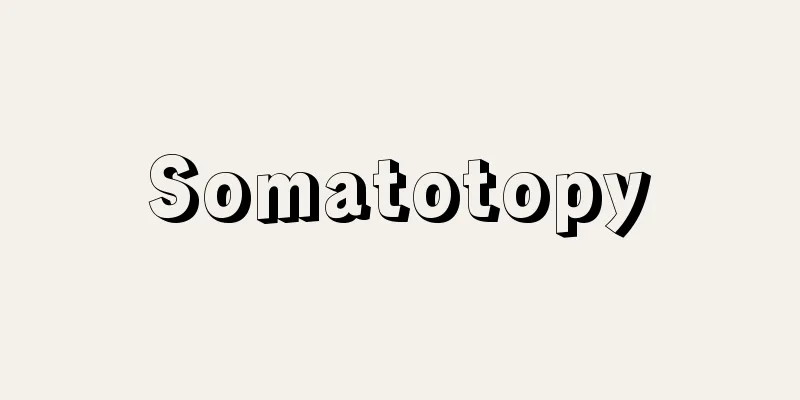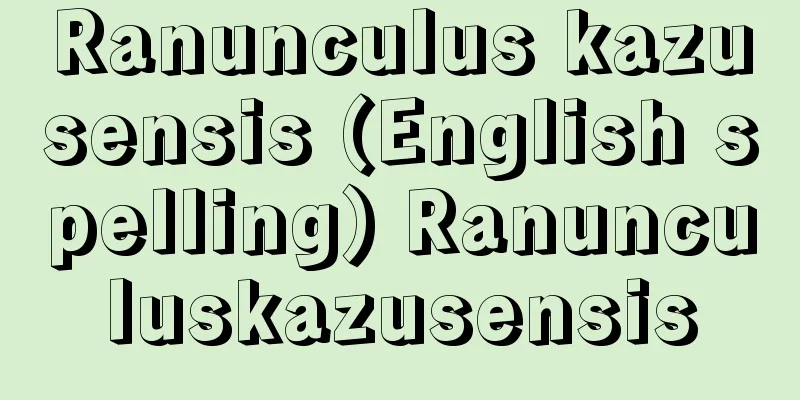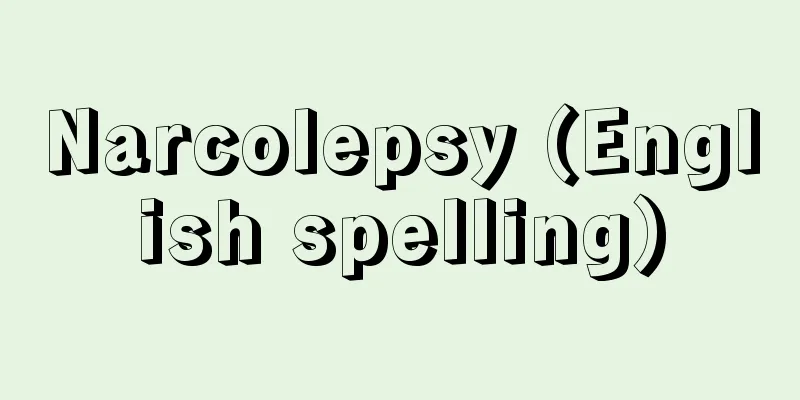Japanese language education - Nihongo Kyoiku

|
Education for speakers who do not have Japanese as their first language. There are four main types of education depending on the purpose of learning: (1) Japanese as a foreign language: When studying Japanese for a certain purpose for a certain period of time. (2) Japanese as a second language: When a person does not return to the country where he or she learned his or her mother tongue (first language), but settles in Japan and learns Japanese as a second language rather than as a foreign language. (3) Japanese as a heritage language: This is when children of Japanese descent living overseas study Japanese with the aim of preserving and passing on the language and culture of their parents' generation. (4) Japanese as the national language: For example, children and students of Japanese families living overseas who study Japanese as a national language subject at Japanese supplementary schools. Generally, when people talk about Japanese language education, it is used to mean (1) which has the largest number of learners. Compared to national language education for Japanese citizens, Japanese language education has significant differences in educational philosophy, teaching content and methods, learning problems, etc. Furthermore, learners are extremely diverse in terms of their nationality, mother tongue, age, academic background, career, motivation and purpose for learning, goals to be achieved, learning period, learning environment, etc., so it is necessary to develop teaching methods, level-specific curricula, teaching materials and tools, and learning materials that support Japanese language education that suits these various conditions. [Kunio Okuda] HistoryFrom the Meiji period until the end of World War II, Japanese language education had a strong tendency to play a part in the domination of other ethnic groups in colonies through the use of Japanese language and culture, and the use of Japanese was forced in Japanese colonies such as Taiwan, the Korean Peninsula, and the former Manchuria (northeastern China). Furthermore, Japanese language education in Southeast Asian countries that Japan aimed to create the Greater East Asia Co-Prosperity Sphere was more of a national language education character that suppressed the use of students' mother tongue and aimed at the imperialization policy, rather than teaching Japanese as a foreign language. The research of Yamaguchi Kiichiro, who compiled books such as "Kokugo to shite no kokugo kyoho" (1933) and "Nihongo kyoho genron" (The Principles of Japanese Language Teaching) (1943) based on the practice of Japanese language education in Japanese colonies, deserves special mention. Meanwhile, in America, in order to gain an advantage on the war front against Japan, the results of the scientific analysis of the Japanese language by linguist Bernard Bloch (1907-65) and others using structural linguistic methods were utilized in the teaching of the Army's Special Intensive Japanese Language Course, and this produced many pro-Japan people such as Donald Keene and Seidensticker, in stark contrast to Japan, where the use of English was banned as an enemy language. Bloch's Japanese language research later had a major influence on the Japanese language research of Teramura Hideo (1928-90), among others. After the Second World War, as Japan's political and economic status in the international community improved, Japanese language education came to be valued as a means of peaceful international exchange and a foundation for understanding different cultures, and the number of Japanese language learners overseas has been steadily increasing year by year. In order to quickly achieve the same level of international student acceptance as Western countries, the government announced the "300,000 International Students Plan" in 2009, aiming to achieve this goal by 2020. [Kunio Okuda] Japanese language education in JapanLooking at Japanese-language education in Japan by learning objectives, the results are as follows: (1) Preparatory Japanese language education, Japanese language and Japanese affairs education, and specialized education in Japanese, aimed at helping international students acquire the Japanese language skills necessary for their studies and research activities at universities and graduate schools. The fields of expertise of international students are wide-ranging, including humanities, science and engineering, medicine, dentistry, and pharmacy, and it is desirable to develop an academic syllabus (detailed coursework) that combines Japanese language education and specialized education. These are carried out at the international student center or special department within the university. (2) Japanese language education for international students and pre-school students who study Japanese at Japanese language schools with the aim of entering vocational schools, universities, or graduate schools. As of July 2010, pre-school students have been unified into the category of international students. (3) Crash course Japanese language education for technical trainees from overseas accepted by companies, etc. (4) Japanese language education for nurse and care worker candidates coming to Japan based on economic cooperation agreements, etc. Special ingenuity and consideration will be required, such as providing furigana readings for kanji characters in national examination questions. (5) Japanese language education as a second language within the school curriculum for children and students such as those living overseas (returnees) and children of foreign workers. (6) Education of everyday Japanese language for foreign residents conducted by volunteers at local community centers, etc. This requires the promotion of a multicultural society by the government. (7) Education of business Japanese for foreign businessmen working in Japan. In this way, Japanese language education in Japan is becoming more diverse. Furthermore, the spread of Japanese language courses through mass media such as NHK Educational TV and satellite broadcasting is helping to broaden the base of Japanese language education. The number of Japanese language learners in Japan is 166,631, with over 70% of them studying at general institutions and facilities such as Japanese language schools. The largest number of learners come from China, followed by South Korea, Brazil, the United States, Taiwan, the Philippines, Vietnam, Indonesia, Thailand, Japan, Peru, Nepal, India, France, the United Kingdom, Malaysia, Germany, etc. (All data from the Agency for Cultural Affairs, 2008). The learners' native languages are also diverse, including Chinese, English, Korean, Portuguese, Japanese, Filipino, Thai, Malay, Indonesian, and Spanish, so there is a need for contrastive linguistic research for Japanese language education and the development of teaching materials and learning materials for each native language (Chinese character and non-Chinese character countries). The Japanese Language Proficiency Test, which measures the Japanese language proficiency of foreign learners of Japanese, began in 1984 (Showa 59), and the number of test takers has increased every year, with 109,247 people taking the test in Japan and 449,810 people taking the test overseas in 2008 (Heisei 20). Since 2010, it has been implemented as the New Japanese Language Proficiency Test. Meanwhile, for Japanese language teachers, the Japanese Language Teaching Proficiency Test has been administered since 1986 to certify that they are capable of teaching Japanese at Japanese language schools. In 1989, the Association for the Promotion of Japanese Language Education was established to improve the quality of Japanese language schools, and is responsible for inspecting and certifying Japanese language education facilities. The main research institutes for Japanese language education in Japan include Japanese language teacher training courses at universities and graduate schools, and international student centers. The National Institute for Japanese Language and Linguistics, established in 1923, has accumulated research on the Japanese language and Japanese language education for many years, but became an independent administrative institution in 2001 and was transferred to the Inter-University Research Corporation National Institutes for the Humanities in 2007, where it continues to carry out research activities. Nationwide academic societies include the Japanese Language Education Society and the Intercultural Education Society. As our society becomes increasingly internationalized, the government needs to come up with a consistent policy to promote Japanese language education. [Kunio Okuda] Japanese Language Education AbroadThe number of Japanese language learners overseas has been increasing year by year, and while it was less than one million in 1990, it exceeded 2.1 million at the end of the 1990s and reached 2.98 million in 2006. The countries and regions with the largest number of Japanese language learners are South Korea (910,975), China (684,366), Australia (366,165), Indonesia (272,719), Taiwan (191,367), the United States (117,969), Thailand (71,083), Vietnam (29,982), and New Zealand (29,904). Universities in Europe, the United States, and Oceania have been researching and teaching Japanese as a foreign language for a long time, and are producing excellent experts in the field. For a long time, Japanese language education overseas was centered on (1) training of Japanese scholars at universities and graduate schools, (2) foreign language courses at universities, (3) mother tongue education for children of Japanese descendants at Buddhist temples, and (4) public relations activities for Japanese culture through Japanese language courses at overseas diplomatic missions. However, a notable trend since the 1980s has been a rapid increase in the number of learners at primary and secondary education institutions. Countries with many learners at primary and secondary education institutions include South Korea (approximately 770,000), Australia (approximately 350,000), Indonesia (approximately 240,000), China (approximately 80,000), Taiwan (approximately 60,000), the United States (approximately 60,000), Thailand (approximately 30,000), and New Zealand (approximately 30,000). In particular, in Australia and New Zealand, learners at primary and secondary education institutions account for more than 90% of Japanese language learners (all data from the Japan Foundation, 2006). Therefore, in addition to the traditional Japanese language teaching materials at the university level, there is an urgent need to develop Japanese language teaching materials and teaching methods for younger learners in their native language. Unlike in Japan, Japanese language education overseas is homogeneous in the native language of learners, making it easier to use the learners' native language as the intermediary language in the classroom and to systematize and enrich Japanese language education to meet local needs (demands). In the 21st century, there has been an increase in learners around the world who are trying to learn Japanese and Japanese culture on their own, without relying on school education, through the Japanese language found in anime and manga. Furthermore, there are cases of people whose first language is not Japanese, such as the American Levy Hideo (1950-) and the Chinese Yang Yi (1964-), who have become writers in Japan and won major awards. This can be seen as the result of actively studying Japanese from an early age. Organizations that support the promotion of Japanese language education overseas include the Japan Foundation and the Japan International Cooperation Agency (Japan Overseas Cooperation Volunteers). Additionally, there are academic societies for Japanese language teachers in America, European countries, Australia, China, South Korea, Taiwan, and other countries, which have been holding the International Association for Japanese Language Education (IALE) every two years since 2004 in cooperation with the Japan Association for Japanese Language Education. Around 1995, the United States began developing Japanese language education standards to determine methods of teaching and learning Japanese, as well as the standards for evaluating learning outcomes. Similar research has since been conducted in EU countries and by the Japan Foundation. [Kunio Okuda] assignmentFuture challenges for Japanese-language education include: (1) training Japanese-language teachers who can meet the needs of diverse learners and establishing a system for reeducating current teachers, (2) research into the content and methods of Japanese-language education, (3) improving and enhancing the Japanese-Language Teaching Competency Examination to screen and certify the knowledge and ability levels of Japanese-language teachers, (4) improving the New Japanese-Language Proficiency Test to comprehensively evaluate the Japanese-language proficiency of Japanese-language learners, and improving and enhancing the Examination for Japanese University Admissions, which is administered both domestically and overseas, for students studying in Japan, (5) developing teaching materials and curricula according to native language, level, field of expertise, and learning objectives, (6) promoting Japanese-language education using IT, (7) disseminating Japanese as an international language, (8) aiming for coexistence in a multilingual and multicultural society, preventing the loss of learners' native language and culture through Japanese-language education and enhancing bilingual education, and (9) internationalizing the Japanese people through communication with foreigners. [Kunio Okuda] Teramura Hideo, "Syntax and Meaning of the Japanese Language," 3 volumes (1982-1991, Kuroshio Publishing) ▽ Miyaji Yutaka et al., eds., "Lecture Series on Japanese Language and Japanese Language Education," 16 volumes (1989-1991, Meiji Shoin) ▽ Okuda Kunio, ed., "Japanese Language Education," (1992, Fukumura Publishing) ▽ Aoki Naoko, Ozaki Akito, and Toki Satoshi, eds., "For Students of Japanese Language Education," (2001, Sekai Shiso Sha) ▽ Kitahara Yasuo, ed., "Problematic Japanese," (2004, Taishukan Shoten) ▽ The Japanese Language Education Society, ed., "Encyclopedia of Japanese Language Education," New Edition (2005, Taishukan Shoten) ▽ Nuibe Yoshinori, editor, "Lecture Series on Japanese Language Education," 6 volumes (2005-2006, Three A Network) ▽ "100 Questions Foreigners Frequently Ask Japanese-Language Teachers," by Ikuko Sakairi et al., revised edition (2007, Babel Press)" ▽ "The Current State of Japanese-Language Education Overseas: Survey of Japanese-Language Education Institutions 2006," edited by the Japan Foundation, revised edition (2008, Bonjinsha) ▽ "Japanese-Language Education Yearbook," edited by the National Institute for Japanese Language and Linguistics, various annual editions (Kuroshio Publishing)" [References] | | | | | | | | Agency| |Japan for Japanese Language and Linguistics| | | | | | |Source: Shogakukan Encyclopedia Nipponica About Encyclopedia Nipponica Information | Legend |
|
日本語を第一言語としない話者に対する教育。学習の目的によって、おもに次の4通りに区別される。 (1)外国語としての日本語教育Japanese as a foreign language 日本語をある目的で一時期学習する場合。 (2)第二言語としての日本語教育Japanese as a second language 母語(第一言語)を習得した出身国に戻らず、日本に定住して日本語を外国語としてではなく第二言語として学習する場合。 (3)継承語としての日本語教育Japanese as the heritage language 海外に在住する日系人子弟が親世代の言語文化を保持し継承することを目ざして学習する場合。 (4)母国語としての日本語教育Japanese as the national language 海外に居住する日本人家族の児童・生徒たちが日本語補習校などで日本語を国語の教科目として学習する場合など。 一般的に日本語教育という場合は、学習者数がもっとも多い(1)の意味で用いられる。日本語教育は、日本国民に対する国語教育と比べて、その教育理念、指導内容および方法、学習上の問題点などに大きな相違がみられる。また、学習者の国籍・母語・年齢・学歴・経歴、学習の動機や目的、到達目標、学習期間、学習環境などもきわめて多様なため、これらの諸条件に適合するような日本語教育を支える教授法、レベル別カリキュラム、母語別・目的別教材や教具、学習材の開発が必要である。 [奥田邦男] 沿革明治期以降、第二次世界大戦終了までの日本語教育は、植民地における他民族への日本語・日本文化による支配の一翼を担う傾向が強く、日本の植民地となった台湾、朝鮮半島、旧満州(中国東北部)では、日本語の使用が強制された。さらに、日本が大東亜共栄圏を目ざした東南アジア諸国で行われた日本語教育も、外国語としての日本語教育というよりは、学習者の母語の使用を抑圧し、皇民化政策を意図した国語教育的性格が強かった。日本の植民地での日本語教育の実践をもとに、『外国語としての我が国語教授法』(1933)、『日本語教授法原論』(1943)などをまとめた山口喜一郎の研究は特筆すべきである。一方、アメリカにおいては、対日戦線を有利に導くために、言語学者ブロックBernard Bloch(1907―65)らの構造言語学的手法による日本語の科学的分析の成果が、陸軍特別集中日本語コースの教育に生かされ、ドナルド・キーン、サイデンステッカーなど多くの親日家を輩出したのは、敵性言語として英語の使用を禁じた日本とは対照的である。ブロックの日本語研究は、その後、寺村秀夫(1928―90)の日本語学研究などに大きな影響を与えた。 第二次世界大戦後は、国際社会における日本の政治的・経済的地位の向上に伴い、日本語教育は平和的な国際交流のための手段、異文化理解の基礎として重視され、海外の日本語学習者数は年々増加の一途をたどっている。政府は欧米諸国並みの留学生受入れを早期に達成するため2009年(平成21)「留学生30万人計画」を発表、2020年の目標達成を目ざしている。 [奥田邦男] 国内の日本語教育国内の日本語教育を学習目的別にみると、以下のようになる。 (1)大学・大学院などで、留学生が勉学、研究活動を行うために必要な日本語能力習得を目ざした日本語予備教育、日本語・日本事情教育、日本語による専門教育。留学生の専門領域は文科系、理工系、医歯薬系など幅広く、日本語教育と専門教育の連携によるアカデミック・シラバス(授業細目)の構築が望まれる。大学内の留学生センターや留学生別科で行われる。 (2)日本語学校等で専門学校、大学、大学院への入学を目ざして日本語を学ぶ留学生・就学生を対象にした日本語教育。なお2010年(平成22)7月より就学生は留学生に一本化された。 (3)企業等が受け入れる海外からの技術研修生を対象にした速習日本語教育。 (4)経済協力協定などに基づいて来日する看護師・介護福祉士候補者のための日本語教育。国家試験の設問の漢字に振り仮名をつけるなど特別な工夫や配慮も必要である。 (5)海外子女(帰国子女)、外国人労働者の子弟などの児童・生徒を対象にした、学校教育のなかで行われる第二言語としての日本語教育。 (6)地域の公民館等でボランティアたちによって行われる、定住外国人を対象にした生活日本語の教育。これには行政による多文化共生社会の推進が必要である。 (7)日本国内の企業で働く外国人ビジネスマンを対象にしたビジネス日本語の教育。 このように、日本国内における日本語教育は多様化の傾向がみられる。また、NHKの教育テレビや衛星放送などのマスメディアによる日本語講座の普及は、日本語教育の裾野(すその)を広げるのに役だっている。 国内の日本語学習者の数は16万6631人に上り、日本語学校など一般の機関・施設における学習者がそのうちの7割以上を占める。学習者の出身国・地域は中国がもっとも多く、以下、韓国、ブラジル、アメリカ、台湾、フィリピン、ベトナム、インドネシア、タイ、日本、ペルー、ネパール、インド、フランス、イギリス、マレーシア、ドイツなどと続く(データはすべて2008年、文化庁調べ)。学習者の母語も、中国語、英語、韓国・朝鮮語、ポルトガル語、日本語、フィリピノ語、タイ語、マレー語、インドネシア語、スペイン語などと多様であり、日本語教育のための対照言語学的研究や母語別(漢字圏・非漢字圏別)教材や学習材の開発が必要である。 1984年(昭和59)に外国人日本語学習者の日本語能力を測定する「日本語能力試験」が始まり、受験者は年々増加し、2008年(平成20)には日本国内で10万9247人、海外で44万9810人が受験した。2010年からは「新日本語能力試験」として実施されている。 一方、日本語教師に対しては、1986年(昭和61)から日本語学校で日本語を指導する能力があることを認定する「日本語教育能力検定試験」が行われている。1989年(平成1)には日本語学校の質的向上を図るため財団法人日本語教育振興協会が設立され、日本語教育施設の審査・認定にあたっている。 国内のおもな日本語教育の研究機関には、各大学、大学院の日本語教員養成課程、留学生センターなどがある。1923年(昭和23)に設立された国立国語研究所は長年にわたって日本語および日本語教育の研究を蓄積してきたが、2001年(平成13)に独立行政法人となり、2007年には大学共同利用法人人間文化研究機構に移管されて研究活動を継続している。全国的な規模の学会には日本語教育学会、異文化間教育学会がある。 国際化が進む社会のなかで、政府は一貫した日本語教育振興政策を打ち出す必要がある。 [奥田邦男] 海外の日本語教育海外の日本語学習者人口は年々増加の傾向をたどり、1990年時点では100万人に満たなかったが、1990年代末には210万人を超え、2006年(平成18)には298万人に達した。日本語学習者が多い国・地域は、韓国(91万0975人)、中国(68万4366人)、オーストラリア(36万6165人)、インドネシア(27万2719人)、台湾(19万1367人)、アメリカ(11万7969人)、タイ(7万1083人)、ベトナム(2万9982人)、ニュージーランド(2万9904人)の順である。欧米やオセアニアの大学では、早くから外国語としての日本語の研究と教育が行われ、優れた専門家を輩出している。 海外の日本語教育は長い間、(1)大学・大学院における日本研究者養成、(2)大学における外国語科目、(3)仏教寺院等による日系人子弟向けの母国語教育、(4)在外公館日本語講座による日本文化の広報活動、などが中心であった。しかし、1980年代以後の著しい傾向として、初等・中等教育機関における学習者の急増がみられる。初等・中等教育機関での学習者が多い国は、韓国(約77万人)、オーストラリア(約35万人)、インドネシア(約24万人)、中国(約8万人)、台湾(約6万人)、アメリカ(約6万人)、タイ(約3万人)、ニュージーランド(約3万人)などとなっている。とくに、オーストラリアとニュージーランドでは、日本語学習者の90%以上を初等・中等教育機関の学習者が占める(データはすべて2006年、国際交流基金調べ)。そのため、従来の大学レベルにおける日本語教材に加えて、年少者のための母語別日本語教材および指導法の開発が急務である。海外の日本語教育は日本国内の場合と違って、学習者の母語が均質であることから、教室の媒介言語として学習者の母語を活用し、現地のニーズ(要求)にあった日本語教育の体系化と充実を図りやすい。 21世紀に入り、アニメや漫画の日本語を通して、学校教育によらずに独学で日本語・日本文化を習得しようとする学習者が世界各地に増えている。さらに、アメリカ人のリービ英雄(1950― )や中国人の楊逸(ヤンイー)(1964― )のように日本語を母語としない人たちが日本で作家活動を行ない、主要な賞を受賞するケースもみられる。早い時期から積極的に日本語を学んだ結果であるといえる。 海外での日本語教育振興を支援する機関として、国際交流基金、国際協力機構(青年海外協力隊)などがある。また、アメリカ、ヨーロッパ各国、オーストラリア、中国、韓国、台湾などには日本語教師の学会があり、日本語教育学会と連携して2004年(平成16)以降、隔年で国際日本語教育学会が開催されている。 なお、1995年ころからアメリカで日本語の教育・学習方法、学習成果の評価の基準を決める日本語教育スタンダードの開発が始まり、その後、EU各国や日本の国際交流基金でも同様の研究が進められている。 [奥田邦男] 課題今後の日本語教育の課題としては、(1)多様な学習者のニーズに対応できる日本語教員の養成、現職教員の再教育体制の確立、(2)日本語教育の内容・方法の研究、(3)日本語教員の知識・能力水準の審査、認定を目的とした「日本語教育能力検定試験」の整備充実、(4)日本語学習者の日本語能力を総合的に評価する「新日本語能力試験」の充実、国内および海外で実施されている日本留学のための「日本留学試験」の整備充実、(5)母語別、レベル別、専門領域別、学習目的別の教材およびカリキュラムの開発、(6)IT(情報技術)を活用した日本語教育の促進、(7)国際語としての日本語の普及、(8)多言語・多文化社会における共生を目ざして、日本語教育による学習者の母語・母文化の喪失を防ぎ、バイリンガル教育の充実を図ること、(9)外国人とのコミュニケーションを通じた日本人の国際化、などがあげられる。 [奥田邦男] 『寺村秀夫著『日本語のシンタクスと意味』全3巻(1982~1991・くろしお出版)』▽『宮地裕他編著『講座 日本語と日本語教育』全16巻(1989~1991・明治書院)』▽『奥田邦男編著『日本語教育学』(1992・福村出版)』▽『青木直子・尾崎明人・土岐哲編『日本語教育学を学ぶ人のために』(2001・世界思想社)』▽『北原保雄編『問題な日本語』(2004・大修館書店)』▽『日本語教育学会編『日本語教育事典』新版(2005・大修館書店)』▽『縫部義憲監『講座・日本語教育学』全6巻(2005~2006・スリーエーネットワーク)』▽『酒入郁子他著『外国人が日本語教師によくする100の質問』新装版(2007・バベルプレス)』▽『国際交流基金編著『海外の日本語教育の現状――日本語教育機関調査・2006年』改訂版(2008・凡人社)』▽『国立国語研究所編『日本語教育年鑑』各年版(くろしお出版)』 [参照項目] | | | | | | | | | | | | | | | | | |出典 小学館 日本大百科全書(ニッポニカ)日本大百科全書(ニッポニカ)について 情報 | 凡例 |
>>: Japan Kodokai - Japan Kodokai
Recommend
Amida Hijiri
Kuya Kuuya Another name for the master. From the ...
Princess Waban
A Chinese princess who married a ruler of a diffe...
Amazon Plain - Amazon Heiya
...This plateau is also home to Brazil's high...
Aizankei [Hot Springs] - Aizankei
This hot spring is located in the southern part of...
Kippenberg, A.
…During the time of the East-West division, the c...
Shugeishuchiin - Shugeishuchiin
An educational institution for the common people ...
Accounts receivable purchasing business - Urikkakesaikenkaitorigyom
...The business of purchasing accounts receivable...
Griechenland
…In Latin, it is Graecia, and in modern European ...
All things in the universe
All the countless things that exist in the univers...
Curly River
…This opera has been translated and performed in ...
Ryuunmon
A pattern that was widely used in the Han dynasty ...
Money drum - Zenidaiko
〘 noun 〙① A child's toy. A small drum. It is s...
Rasbora heteromorpha (English spelling)
...Their characteristics are the same as those of...
Iwayadono - Iwayadono
…A rock cave dug into a mountainside in medieval ...
Sinking fund - Gensai Kikin
A system for setting aside funds necessary to rep...









